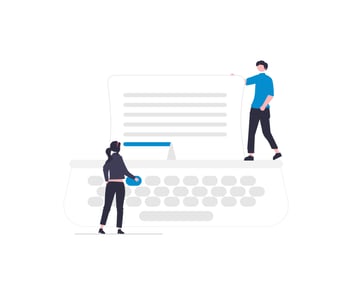How do you measure Customer Experience?
The way your people feel when interacting with your brand has a significant impact on how successful you will be in converting them into loyal paying customers. That’s where Customer Experience comes in. If you’re pouring time and resources into your business, it’s important to know that it’s going towards the right things.
By monitoring and understanding the experience your customers have, you can be more informed about what they need and how to keep them happy. That’s why in this article we dive into what Customer Experience is and how to make yours work for you.
An overview of Customer Experience
If your customers feel satisfied and supported when they interact with your brand, they’re more likely to stick around and that’s why tracking Customer Experience (CX) is increasingly valuable. From the moment a customer discovers you to the moment they purchase a product or interact with customer service, Customer Experience is all about how they feel about your brand. By improving how customers feel when they interact with you, you can ensure your customer service, products, and communication are as good as they can be.
A higher level of Customer Experience will reflect a brand that values its customers and puts their needs first. To achieve this, businesses must be engaging and make each step of the customer journey as effortless as possible.
A good Customer Experience includes:
- Finding what they need easily.
- Receiving excellent support from the brand as needed.
- Being satisfied with the products or services they invest in.
- Getting clear and transparent answers to their questions.
- Being communicated with in a way that suits them, through the channels they prefer to use.
- User-friendly navigation of the website without any technical difficulties.
- Engaging with marketing campaigns that are relevant and interesting.
Why does Customer Experience matter?
To succeed in business, you should have a customer-centric approach, since happy customers are more likely to stay loyal, promote you to others, and make repeat purchases. In business interactions, the customers are the ones who hold the power since they can easily find another provider or company to meet their needs. So if your brand is failing to meet their expectations, they’ll simply look elsewhere.
But, if you can focus your efforts on refining the Customer Experience you offer, your customers will feel valued, heard and taken care of. That gives them a reason to keep up the relationship and continue investing with you.
Measuring Customer Experience
There are a few different ways to measure Customer Experience and each one offers a slightly different benefit. As a brand, you can use these metrics to understand how customers feel at any given point in their experience with a brand.
Net Promoter Scores (NPS)
A Net Promoter Score survey asks customers whether they are likely to recommend a brand to a friend. If you don’t need detailed responses, an NPS survey will allow you to track overall trends in customer satisfaction. They have been popular around the world for over 20 years but many businesses have realised the results are often too vague to encourage positive change. If you want to know exactly where your Customer Experience is falling short, NPS won’t help you.
Customer Satisfaction Scores (CSAT)
Customer Satisfaction questions ask customers how satisfied they are with a certain aspect of their experience with a brand. Rather than giving a generalised response, they offer timely, insightful, and relevant feedback. If you want to target customers at the right point in the buyer’s journey, CSAT surveys are the best place to start.
Customer Effort Scores (CES)
Customer Effort Score (CES) surveys give customers the chance to share how easy it is to deal with a brand. This makes them a crucial metric for tracking Customer Experience because in knowing how effortless, or frustrating their experience was, you can also deduce how likely they are to continue the relationship.
Customer Experience management
Customer feedback should be organized, measurable, and easy to understand. So if you want feedback to be a valuable asset, rather than a drain on your resources, you need the right tools. In many cases, customer feedback is used as an extra, optional add-on to business strategy but when it’s applied consistently, strategically and with clear goals in place, the Customer Experience is guaranteed to improve.
That’s why having a management platform to automate, centralise and simplify the customer feedback process is critical. With the right software, businesses can make the most of their customer feedback without it taking up too much time or energy.
A customer feedback management tool should offer:
- Simple survey building and intuitive user interface.
- The most relevant metrics for your needs, including CES and CSAT.
- Automated surveys to target relevant customers.
- The organisation of all responses into one convenient location.
- Feedback analytics to extract trends and insights from survey responses.
- Dashboard to see all responses and Customer Experience data clearly.
- Integration with your other business tools, especially your CRM.
- Ability to use your survey responses in your marketing.
At Review Tui
Review Tui gives you the tools you need to capture customer insights and improve your Customer Experience. With easy reporting, an intuitive survey builder, Hubspot integration, and the ability to use multiple communication channels, Review Tui has everything you need to start today.
Real-time alerts
With Review Tui, you can easily keep track of all your customer responses by using automatic response alerts. Each time a customer leaves feedback, you’ll get a quick, convenient notification.
Personalisation
Review Tui has integration with Hubspot so that you can have everything linked. That means your survey results can be sent to your HubSpot CRM for personalised follow-up.
Multiple channels
With Review Tui you can use a wide range of channels to communicate with your customers. Whether email, QR codes, social media, website live chat, text or survey links are their preferred channel, you can make it as easy as possible to respond.
In today's world, Customer Experience is crucial, which is why businesses are becoming more and more attentive to their customers. If you choose not to listen to their concerns, they're likely to turn to your more customer-centric competitors. But thanks to the use of customer feedback tools, you don't have to figure it all out on your own.
For more suggestions and tips to get started, download our guide to implementing a customer feedback strategy.



